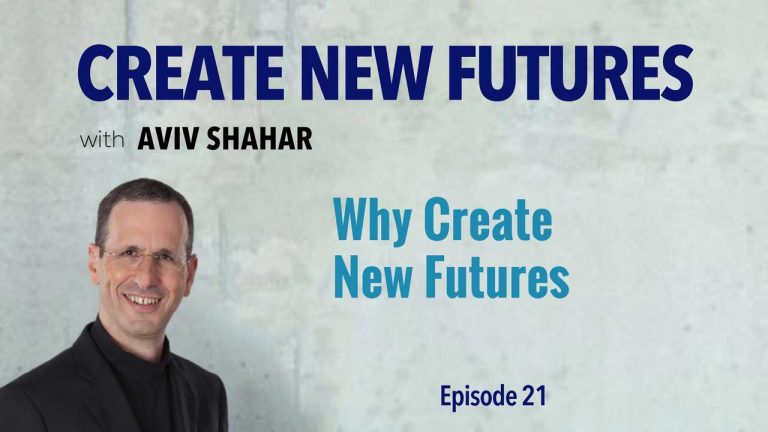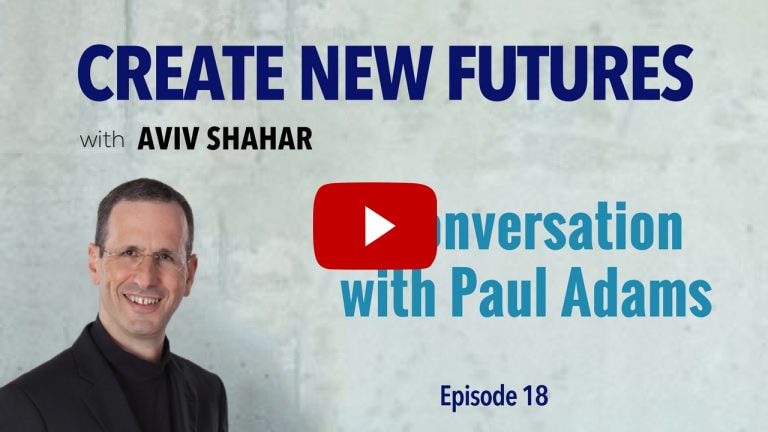Hi Leader,
"What is the highest point of leverage for you?" is the question I ask a group of entrepreneurs. This video reel includes comments from those CEOs about their experience.
"Why create new futures?" is the question I address in the preface to my book. More than ever, organizations large and small, and humanity at large now need people who are prepared to imagine and create new futures. This is a time of disruptive and transformative change. It demands your best imagination, courage and creativity. Here below is the audio recording of the preface. You can download the entire audio book here.
Why Create New Futures

Create New Futures does not adhere to a linear, chronological story. Thus, you can extract immediate value simply by turning to any page and reading for a few minutes. This approach was intentional, and I share my thinking here briefly because it reflects the evolution of my discovery journey. Old movies like Ben Hur and The Ten Commandments begin a storyline, follow with an intermission, and then continue the chronology of the plot timeline. Somewhere in the mid-1980s and early 1990s, however, script writers began to employ the innovation of retracing up and down the timeline.
The evolution of this medium caught my attention because it reflects the development of the human capacity to become more universal and less locally based, less time-bound and more adaptive and timeline-flexible.
It also demonstrates audiences' growing sophistication. The public at large seems to be amenable to abandon the Newtonian cause and effect linearity and ready to embrace a more complex network appreciation. The "Digital Natives" who were born in the post-Internet age are not bound by alphabetical order. Their brains have been wired into the Internet topography, where every word and idea has become a clickable portal that furthers the search for a deeper exploration. We all are now experiencing this discovery by getting used to reading in the middle and going with the flow of our interests. For this reason, I have built this book around portals, rather than chapters.
We no longer are bound by the linear cause and effect universe. Instead, we have the freedom to entertain mind-bending ideas. The legacy view that the past defines the future has been overlaid by a "flying upside down" view that contemplates a reverse flow in which the future reframes the past. What an exciting philosophical and spiritual concept!
In my workshops, my clients experience this new-found ability when we engage in the Sacred Stories Circle. In this process, I ask people to share formative experiences that contain teachable insights. I use them to demonstrate how we can attach new meaning and significance to an earlier experience from the vantage point of our current content and appreciation. This is a simple example of how we can enable the present and future to update our past.
The point of this example of how I help clients expand their thinking is to free you to explore this book any way you choose. Just as the moments and experiences described in this book trace back and forth in time, so, too, I invite you to let your interests guide your discovery journey.
The vignettes that follow are all part of my discovery journey instigated by the propelling inquiry of this book: what creates the future? I have integrated my personal and professional experiences to provide immediacy of access, to offer a practical translation of ideas, and to demonstrate how I have applied these techniques in my work. I hope this approach will inspire you to become more purposefully present in your life than you are now.
My task in Create New Futures is to inspire you to be tomorrow's agent, and to create conversations that birth a new future.
"Your future can update your past." That's a mind-bender of an idea. How can tomorrow redefine yesterday?
My conversation with Paul Adams, whose key points are highlighted below, is a special turn-the-table episode. President and founder of Sound Financial Group, Paul is an accomplished speaker and author. In his two books, Stop Burning Your Money and Sound Financial Advice, he shares his specialized financial expertise and coaching style. After reading my book, Create New Futures, Paul invited me to be a guest on his podcast, Sound Financial Bites , so we could explore the specific questions my book triggered for him.
As a student of life and of what works, Paul insisted that our conversation focus on the pragmatic applications of the points we explored. I enjoyed our dialogue, and I trust you will too.

Key Learning:
- "Your future and present can update your past." Reclaim your power-the power to choose, to be self-directed, and to defy the crippling mindset that says what happened to you yesterday defines who you are today. Instead, why not embrace this reframed perspective: your today can redefine your yesterday?
- Do you allow crisis to define your future, or do you choose to create a future that redefines and transcends your challenging experiences?
- What can we learn from Pope John Paul II's formative experience as a young man in an underground theater during World War II that shaped his later role in life?
- "Instead of thinking that today is the product of yesterday, think of today as the beginning of tomorrow." This mental model proposes that what appears to be a setback can become the setup for new beginnings that lead to your next breakthrough.
- How can parents foster the can-do mindset with their children? By creating a dual memory: one of the incidence of success and the other of the experience of overcoming the challenge that enabled the success.
- Why and how did Aviv reframe a devastating loss in the Air Force into a teachable story?
- What is the deeper meaning of integrity? How does Aviv use a story to reinvigorate the essence of integrity?
- "A complaint is the misdirected energy of an unaddressed or unmet need."
- Because many of us internalize and personalize complaints, our natural reaction is defensiveness. A healthy alternative is to understand and help the other person become part of the solution by converting the complaint into a concrete request that will help us address the unmet need.
Now it's your turn. As a leader, you are a transformation agent. How will you apply these ideas to create transformative focus today?
© Aviv Shahar

